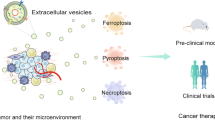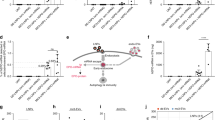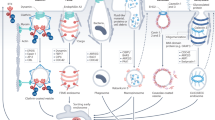Abstract
Since c-Met has an important role in the development of cancer, it is considered as an attractive target for cancer therapy. Although molecular mechanisms for oncogenic property of c-Met have been actively investigated, regulatory elements for c-Met endocytosis and its effect on c-Met signaling remain unclear. In this study, we identified a pivotal endocytic motif in c-Met and tested it for selective modulation of HGF-induced c-Met response. Using various chimeric constructs with the cytoplasmic tail of c-Met, we were able to demonstrate that a dileucine motif located in the C-terminus of c-Met acts to regulate its endocytosis. Synthetic peptide Ant-3S, consisting of antennapedia-derived protein transduction domain (designated as Ant) and c-Met-derived 16 amino-acids (designated as 3S, spanning amino-acids 1378 to 1393), rapidly moved into cancer cells and disrupted c-Met trafficking. Importantly, an extension of c-Met retention time on the membrane by Ant-3S peptide significantly decreased phosphorylation-dependent c-Met signal transduction. Additionally, the peptide effectively inhibited HGF-induced cell growth, scattering and migration. The underlying molecular mechanism for these observations has been investigated and revealed that the dileucine motif interacts with endocytic machinery, including adaptin β and caveolin-1, for sustained and enhanced signal transduction. Finally, Ant-3S peptide specifically blocked internalization of interleukin-2 receptor α-subunit/3S chimeric protein, but not the other receptors, including Glut4, Glut8 and transferrin receptor. Such results indicate the presence of a selective endocytic assembly for c-Met. It also suggests a potential for c-Met-specific anti-cancer therapy using the identified endocytic motif in this study.
This is a preview of subscription content, access via your institution
Access options
Subscribe to this journal
Receive 50 print issues and online access
$259.00 per year
only $5.18 per issue
Buy this article
- Purchase on Springer Link
- Instant access to full article PDF
Prices may be subject to local taxes which are calculated during checkout





Similar content being viewed by others
References
Polo S, Di Fiore PP . Endocytosis conducts the cell signaling orchestra. Cell 2006; 124: 897–900.
Kermorgant S, Zicha D, Parker PJ . PKC controls HGF-dependent c-Met traffic, signalling and cell migration. EMBO J 2004; 23: 3721–3734.
Kermorgant S, Zicha D, Parker PJ . Protein kinase C controls microtubule-based traffic but not proteasomal degradation of c-Met. J Biol Chem 2003; 278: 28921–28929.
Petrelli A, Gilestro GF, Lanzardo S, Comoglio PM, Migone N, Giordano S . The endophilin-CIN85-Cbl complex mediates ligand-dependent downregulation of c-Met. Nature 2002; 416: 187–190.
Li N, Lorinczi M, Ireton K, Elferink LA . Specific Grb2-mediated interactions regulate clathrin-dependent endocytosis of the cMet-tyrosine kinase. J Biol Chem 2007; 282: 16764–16775.
Singleton PA, Salgia R, Moreno-Vinasco L, Moitra J, Sammani S, Mirzapoiazova T et al. CD44 regulates hepatocyte growth factor-mediated vascular integrity. Role of c-Met, Tiam1/Rac1, dynamin 2, and cortactin. J Biol Chem 2007; 282: 30643–30657.
Kamei T, Matozaki T, Sakisaka T, Kodama A, Yokoyama S, Peng YF et al. Coendocytosis of cadherin and c-Met coupled to disruption of cell-cell adhesion in MDCK cells-regulation by Rho, Rac and Rab small G proteins. Oncogene 1999; 18: 6776–6784.
Peschard P, Fournier TM, Lamorte L, Naujokas MA, Band H, Langdon WY et al. Mutation of the c-Cbl TKB domain binding site on the Met receptor tyrosine kinase converts it into a transforming protein. Mol Cell 2001; 8: 995–1004.
Abella JV, Peschard P, Naujokas MA, Lin T, Saucier C, Urbe S et al. Met/Hepatocyte growth factor receptor ubiquitination suppresses transformation and is required for Hrs phosphorylation. Mol Cell Biol 2005; 25: 9632–9645.
Mettlen M, Stoeber M, Loerke D, Antonescu CN, Danuser G, Schmid SL . Endocytic accessory proteins are functionally distinguished by their differential effects on the maturation of clathrin-coated pits. Mol Biol Cell 2009; 20: 3251–3260.
Le Roy C, Wrana JL . Clathrin- and non-clathrin-mediated endocytic regulation of cell signalling. Nat Rev Mol Cell Biol 2005; 6: 112–126.
Schmidt U, Briese S, Leicht K, Schurmann A, Joost HG, Al-Hasani H . Endocytosis of the glucose transporter GLUT8 is mediated by interaction of a dileucine motif with the beta2-adaptin subunit of the AP-2 adaptor complex. J Cell Sci 2006; 119: 2321–2331.
Doray B, Lee I, Knisely J, Bu G, Kornfeld S . The gamma/sigma1 and alpha/sigma2 hemicomplexes of clathrin adaptors AP-1 and AP-2 harbor the dileucine recognition site. Mol Biol Cell 2007; 18: 1887–1896.
Byland R, Vance PJ, Hoxie JA, Marsh M . A conserved dileucine motif mediates clathrin and AP-2-dependent endocytosis of the HIV-1 envelope protein. Mol Biol Cell 2007; 18: 414–425.
Kelly BT, McCoy AJ, Spate K, Miller SE, Evans PR, Honing S et al. A structural explanation for the binding of endocytic dileucine motifs by the AP2 complex. Nature 2008; 456: 976–979.
Green M, Loewenstein PM . Autonomous functional domains of chemically synthesized human immunodeficiency virus tat trans-activator protein. Cell 1988; 55: 1179–1188.
Liu GS, Cohen MV, Mochly-Rosen D, Downey JM . Protein kinase C-epsilon is responsible for the protection of preconditioning in rabbit cardiomyocytes. J Mol Cell Cardiol 1999; 31: 1937–1948.
Derossi D, Calvet S, Trembleau A, Brunissen A, Chassaing G, Prochiantz A . Cell internalization of the third helix of the Antennapedia homeodomain is receptor-independent. J Biol Chem 1996; 271: 18188–18193.
Lindgren M, Gallet X, Soomets U, Hallbrink M, Brakenhielm E, Pooga M et al. Translocation properties of novel cell penetrating transportan and penetratin analogues. Bioconjug Chem 2000; 11: 619–626.
Joliot A, Pernelle C, Deagostini-Bazin H, Prochiantz A . Antennapedia homeobox peptide regulates neural morphogenesis. Proc Natl Acad Sci USA 1991; 88: 1864–1868.
Lindsay MA . Peptide-mediated cell delivery: application in protein target validation. Curr Opin Pharmacol 2002; 2: 587–594.
Garippa RJ, Johnson A, Park J, Petrush RL, McGraw TE . The carboxyl terminus of GLUT4 contains a serine-leucine-leucine sequence that functions as a potent internalization motif in Chinese hamster ovary cells. J Biol Chem 1996; 271: 20660–20668.
Craven SE, Bredt DS . Synaptic targeting of the postsynaptic density protein PSD-95 mediated by a tyrosine-based trafficking signal. J Biol Chem 2000; 275: 20045–20051.
Clark SG, Shurland DL, Meyerowitz EM, Bargmann CI, van der Bliek AM . A dynamin GTPase mutation causes a rapid and reversible temperature-inducible locomotion defect in C. elegans. Proc Natl Acad Sci USA 1997; 94: 10438–10443.
Kermorgant S, Parker PJ . Receptor trafficking controls weak signal delivery: a strategy used by c-Met for STAT3 nuclear accumulation. J Cell Biol 2008; 182: 855–863.
Derossi D, Joliot AH, Chassaing G, Prochiantz A . The third helix of the Antennapedia homeodomain translocates through biological membranes. J Biol Chem 1994; 269: 10444–10450.
Stein A, Aloy P . Contextual specificity in peptide-mediated protein interactions. PLoS One 2008; 3: e2524.
Ball LJ, Kuhne R, Hoffmann B, Hafner A, Schmieder P, Volkmer-Engert R et al. Dual epitope recognition by the VASP EVH1 domain modulates polyproline ligand specificity and binding affinity. EMBO J 2000; 19: 4903–4914.
Ferracini R, Longati P, Naldini L, Vigna E, Comoglio PM . Identification of the major autophosphorylation site of the Met/hepatocyte growth factor receptor tyrosine kinase. J Biol Chem 1991; 266: 19558–19564.
Tong J, Taylor P, Peterman SM, Prakash A, Moran MF . Epidermal growth factor receptor phosphorylation sites Ser991 and Tyr998 are implicated in the regulation of receptor endocytosis and phosphorylations at Ser1039 and Thr1041. Mol Cell Proteomics 2009; 8: 2131–2144.
Rothenberger S, Iacopetta BJ, Kuhn LC . Endocytosis of the transferrin receptor requires the cytoplasmic domain but not its phosphorylation site. Cell 1987; 49: 423–431.
Cantiani L, Manara MC, Zucchini C, De Sanctis P, Zuntini M, Valvassori L et al. Caveolin-1 reduces osteosarcoma metastases by inhibiting c-Src activity and met signaling. Cancer Res 2007; 67: 7675–7685.
Schroeder B, Weller SG, Chen J, Billadeau D, McNiven MA . A Dyn2-CIN85 complex mediates degradative traffic of the EGFR by regulation of late endosomal budding. EMBO J 2010; 29: 3039–3053.
Kirisits A, Pils D, Krainer M . Epidermal growth factor receptor degradation: an alternative view of oncogenic pathways. Int J Biochem Cell Biol 2007; 39: 2173–2182.
Sorkin A, von Zastrow M . Endocytosis and signalling: intertwining molecular networks. Nat Rev Mol Cell Biol 2009; 10: 609–622.
Liu ZX, Yu CF, Nickel C, Thomas S, Cantley LG . Hepatocyte growth factor induces ERK-dependent paxillin phosphorylation and regulates paxillin-focal adhesion kinase association. J Biol Chem 2002; 277: 10452–10458.
Gomes DA, Rodrigues MA, Leite MF, Gomez MV, Varnai P, Balla T et al. c-Met must translocate to the nucleus to initiate calcium signals. J Biol Chem 2008; 283: 4344–4351.
Joffre C, Barrow R, Menard L, Calleja V, Hart IR, Kermorgant S . A direct role for Met endocytosis in tumorigenesis. Nat Cell Biol 2011; 13: 827–837.
Craig HM, Reddy TR, Riggs NL, Dao PP, Guatelli JC . Interactions of HIV-1 nef with the mu subunits of adaptor protein complexes 1, 2, and 3: role of the dileucine-based sorting motif. Virology 2000; 271: 9–17.
Diviani D, Lattion AL, Abuin L, Staub O, Cotecchia S . The adaptor complex 2 directly interacts with the alpha 1b-adrenergic receptor and plays a role in receptor endocytosis. J Biol Chem 2003; 278: 19331–19340.
Shewan AM, Marsh BJ, Melvin DR, Martin S, Gould GW, James DE . The cytosolic C-terminus of the glucose transporter GLUT4 contains an acidic cluster endosomal targeting motif distal to the dileucine signal. Biochem J 2000; 350 (Pt 1): 99–107.
Flessner LB, Moley KH . Similar [DE]XXXL[LI] motifs differentially target GLUT8 and GLUT12 in chinese hamster ovary cells. Traffic 2009; 10: 324–333.
Wang W, Loh HH, Law PY . The intracellular trafficking of opioid receptors directed by carboxyl tail and a di-leucine motif in Neuro2A cells. J Biol Chem 2003; 278: 36848–36858.
Garnier J, Gibrat JF, Robson B . GOR method for predicting protein secondary structure from amino acid sequence. Methods Enzymol 1996; 266: 540–553.
Lindberg M, Biverstahl H, Graslund A, Maler L . Structure and positioning comparison of two variants of penetratin in two different membrane mimicking systems by NMR. Eur J Biochem 2003; 270: 3055–3063.
Czajlik A, Mesko E, Penke B, Perczel A . Investigation of penetratin peptides. Part 1. The environment dependent conformational properties of penetratin and two of its derivatives. J Pept Sci 2002; 8: 151–171.
Branco MC, Sigano DM, Schneider JP . Materials from peptide assembly: towards the treatment of cancer and transmittable disease. Curr Opin Chem Biol 2011; 15: 427–434.
Rosca EV, Koskimaki JE, Rivera CG, Pandey NB, Tamiz AP, Popel AS . Anti-angiogenic peptides for cancer therapeutics. Curr Pharm Biotechnol 2011; 12: 1101–1116.
Shojaei F, Lee JH, Simmons BH, Wong A, Esparza CO, Plumlee PA et al. HGF/c-Met acts as an alternative angiogenic pathway in sunitinib-resistant tumors. Cancer Res 2010; 70: 10090–10100.
Grepin R, Pages G . Molecular mechanisms of resistance to tumour anti-angiogenic strategies. J Oncol 2010; 2010: 835680.
Al-Hasani H, Yver DR, Cushman SW . Overexpression of the glucose transporter GLUT4 in adipose cells interferes with insulin-stimulated translocation. FEBS Lett 1999; 460: 338–342.
Lisinski I, Schurmann A, Joost HG, Cushman SW, Al-Hasani H . Targeting of GLUT6 (formerly GLUT9) and GLUT8 in rat adipose cells. Biochem J 2001; 358: 517–522.
Acknowledgements
We thank the members of the Kiwon and Young Woo laboratory for their inputs and discussions. We thank Julie Kim and Oh Gordon Chong for editing. This work was supported by the Ministry of Knowledge Economy (Regional R&D Cluster Project B0009735) of Korea.
Author information
Authors and Affiliations
Corresponding authors
Ethics declarations
Competing interests
The authors declare no conflict of interest.
Rights and permissions
About this article
Cite this article
Cho, KW., Park, J., Park, CW. et al. Identification of a pivotal endocytosis motif in c-Met and selective modulation of HGF-dependent aggressiveness of cancer using the 16-mer endocytic peptide. Oncogene 32, 1018–1029 (2013). https://doi.org/10.1038/onc.2012.122
Received:
Revised:
Accepted:
Published:
Issue Date:
DOI: https://doi.org/10.1038/onc.2012.122
Keywords
This article is cited by
-
The unfolded protein response modulators GSK2606414 and KIRA6 are potent KIT inhibitors
Cell Death & Disease (2019)
-
MicroRNA-144 inhibits the metastasis of gastric cancer by targeting MET expression
Journal of Experimental & Clinical Cancer Research (2015)



